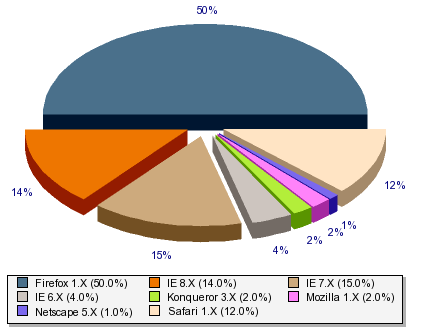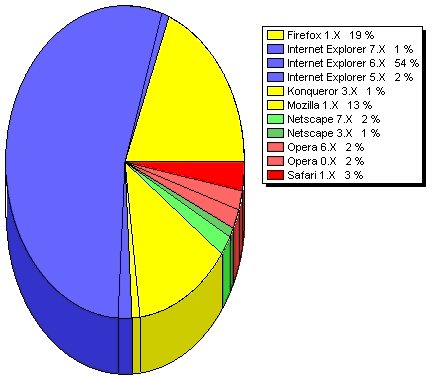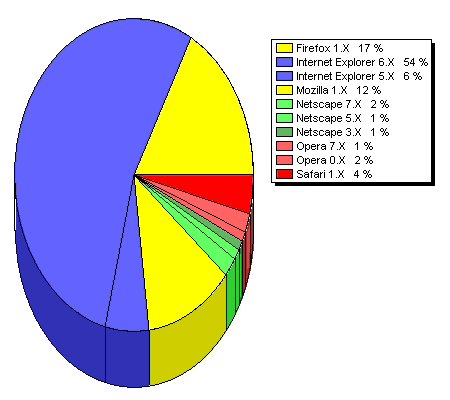 Well, it is more than five years ago that I blogged about the fading away of people using Netscape Navigator 4.x versions to visit my website, a year later about the reduction in people browsing my site with Internet Explorer 5.x and about the first sightings of Internet Explorer 7.
Well, it is more than five years ago that I blogged about the fading away of people using Netscape Navigator 4.x versions to visit my website, a year later about the reduction in people browsing my site with Internet Explorer 5.x and about the first sightings of Internet Explorer 7.
Today things are different, and Microsoft’s Internet Explorer 6.x is the beast that keeps me from implementing cleaner HTML code for this website. But there are good news: In the last months, the number of people visiting this site with Internet Explorer 6.x has more and more often been smaller than the number of users browsing the web with the current 8.x incarnation of the beast. This is good news, because the new version 8.x is much more standards compliant and it finally, finally supports the use of the quote tag <q>. That means that more people will acutally see the quotation marks around the quotes (“” for English, „“ for German) that I coded into this blog and the other pages offered here.
When the amount of IE 6.x users consistently remains below three percent, I will kick out the hacks that I put into the code to work around IE 6.x’s annoyances. Maybe that will also be the day when I will introduce the first pages that are coded in HTML 5, something that I am really looking forward to because the new <video> element will make embedding video in a standards conformant way much easier.
Posts Tagged ‘Internet Explorer’
Bye bye, Internet Explorer 6.
Sunday, August 2nd, 2009Time to update.
Wednesday, November 30th, 2005Yesterday, the Mozilla Foundation has released the new stable version of Firefox. I definitely recommend downloading and installing the 1.5 release if you are on windows. It is more stable, more web compliant, and of course, it includes some security fixes. If you’re using Internet Explorer please give Firefox a test drive for a few days. If people would stop using Internet Explorer versions 6 and prior, the web would become a much more efficient and accessible place because websites could be coded using modern standards without tons of hacks to work around the catastrophe that is Internet Explorer’s rendering engine.
Internet Explorer 7 in the wild.
Thursday, September 29th, 2005 Well, well, seems the future has begun. Hopefully, it will really be a future that is more standards compliant and privacy friendly. Today, I noticed my first visitor using Internet Explorer 7. Makes me wonder, how long it will take to reduce the share of version 6 to the current level of version 5…
Well, well, seems the future has begun. Hopefully, it will really be a future that is more standards compliant and privacy friendly. Today, I noticed my first visitor using Internet Explorer 7. Makes me wonder, how long it will take to reduce the share of version 6 to the current level of version 5…
The referrer said that the Internet Explorer 7 user was googling for Emma Watson (a.k.a. Baby Spice) pictures.
The beast in decline.
Friday, May 27th, 2005 On the diagram you can see a pretty average distribution of browsers visiting my site. Since the free account at SiteMeter only includes browser share statistics for the last 100 visits the variation can be pretty big. Firefox’s share has been increasing over the last few months, although it has been hovering around 20% for the last two months or so. The development which I watch most closely these days is the percentage of Internet Explorer 5.x users that are visiting this site. This has been steadily decreasing and is usually below 10%. What is even better: more than half of the IE 5.x share consists of Mac Internet Explorer versions that are much, much better at rendering according to standards (that is, their Tasman rendering engine keeps up with most of the CSS Level 1 code that I throw at it). This makes the actual share of Windows IE 5.x – a.k.a. the beast – using visitors something below 5%. That in turn means that I will soon stop supporting this browser and rely more heavily on using modern CSS to manage the layout of my page. I did a similar thing when I dropped support for Netscape 4.x versions several months ago. However, in that case I waited until the Netscape 4.x share dropped below 1%. Why do I handle things differently for Win IE 5.x and start dropping support at a share of about 5%? Because windows machines that are able to run IE 5.x are able to run Firefox well enough too. And they should run it because of the tons of security holes that are opened by browsing the web with this hideous beast of a browser.
On the diagram you can see a pretty average distribution of browsers visiting my site. Since the free account at SiteMeter only includes browser share statistics for the last 100 visits the variation can be pretty big. Firefox’s share has been increasing over the last few months, although it has been hovering around 20% for the last two months or so. The development which I watch most closely these days is the percentage of Internet Explorer 5.x users that are visiting this site. This has been steadily decreasing and is usually below 10%. What is even better: more than half of the IE 5.x share consists of Mac Internet Explorer versions that are much, much better at rendering according to standards (that is, their Tasman rendering engine keeps up with most of the CSS Level 1 code that I throw at it). This makes the actual share of Windows IE 5.x – a.k.a. the beast – using visitors something below 5%. That in turn means that I will soon stop supporting this browser and rely more heavily on using modern CSS to manage the layout of my page. I did a similar thing when I dropped support for Netscape 4.x versions several months ago. However, in that case I waited until the Netscape 4.x share dropped below 1%. Why do I handle things differently for Win IE 5.x and start dropping support at a share of about 5%? Because windows machines that are able to run IE 5.x are able to run Firefox well enough too. And they should run it because of the tons of security holes that are opened by browsing the web with this hideous beast of a browser.
The new background image in the main column of this blog is one visible step in the direction redesign and recoding will take – most of the work will remain invisible to those browsing the site. However, that work will enhance accessibility and standards compliance (and propably the search engine ranking too).
Some more optimizations.
Thursday, July 10th, 2003Yesterday I finished fiddling with the HTML and CSS code of my web pages. *sigh*
You probably won’t notice any differences, but everything is much better now. ;-) The blog displays exactly as it should in a ton of different browsers: Internet Explorer 5.0 on Win98, 6.0 on WinXP, 5.23 on MacOS X, several different Mozilla/Firebird/Camino builds on different platforms, Opera 6.02, and Safari (which uses a tweaked version of the rendering engine of Konqueror on Linux). Only the trusty iCab has it’s usual problems with the correct rendering of pretty basic CSS code. But the page still works nicely even in iCab.
The code for my other pages has undergone some optimizations too. It might now be rendering a tad bit faster. It has also been revised to be even more accessible to handicapped people, and people with text browsers or slow connections. Hopefully this also has a positive impact on my google ranking, because I am now using the appropriate tags wherever possible (i.e. I am formatting the contents list using list tags, I am formatting my contact information using the address tag etc.)